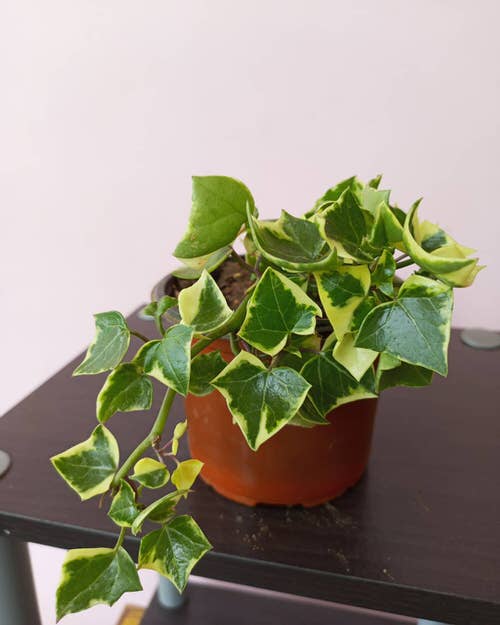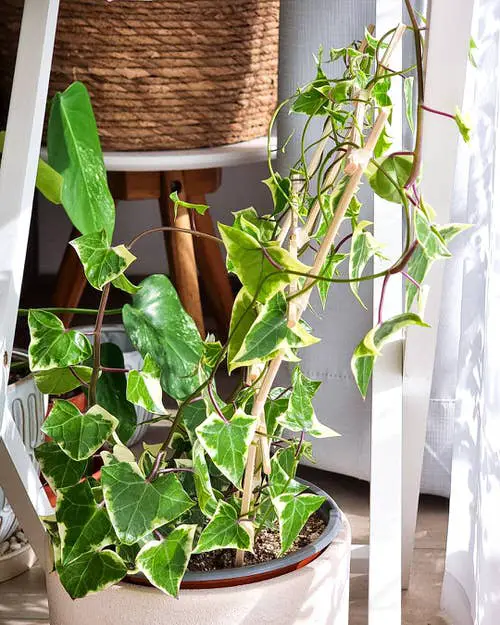Wondering How to Grow Wax Ivy Indoors? We have compiled all the necessary details in this informative article below!

If you want to bring home a unique variegated foliar specimen, you must learn everything about How to Grow Wax Ivy Indoors discussed below. It looks spectacular with its waxy and shiny foliage!
Fine out some indoor English Ivy alternatives here
Wax Ivy Plant Information

Native to South Africa, Wax Ivy is a flowering species of the Asteraceae family, featuring waxy foliage variegated in green and pale yellow. The sharp triangular leaves on the succulent stems look beautiful, cascading down a hanging basket or sprawling a trellis upward.
The plant blooms yellow daisy-like flowers in summer and thrives in warm climates. It is a low-maintenance variety and a pretty common choice among succulent lovers.
Botanical Name: Senecio macroglossus
Check out the best indoor Ivy varieties here
Wax Ivy Propagation
Propagating Wax Ivy through cuttings is straightforward and requires no special gardening skills!
- Get a healthy Wax Ivy and snip a 5-6 inches long stem from above the leaf node.
- Use a sanitized shear to make the cut, barring any chances of fungal infestation.
- Remove the bottom foliage, leaving the upper leaves intact.
- Plant the cuttings in a well-draining growing medium, water well, and place it at a location where it gets bright and indirect light.
- The cuttings will show new growth in 2-4 weeks.
Learn about propagating English Ivy in water here
Requirements For Growing Wax Ivy

Soil
Wax Ivy needs a well-draining medium to thrive well. Garden soil amended with a handful of perlite, vermiculite, birch bark, and compost will make the perfect blend for it.
You may also go for a well-aerated succulent or cactus mix from the market to make your work easier.
Sunlight
Native to the warm African climate, the plant loves the bright sun. Ensure it receives 3-4 hours of bright sunlight. While growing indoors, hang it on the porch or balcony that soaks in the morning sun to give the trailing beauty an ideal growing condition.
However, the scorching afternoon sun might burn the foliage.
Water
Wax Ivy hates to stand in water. So let the medium dry out between watering sessions. Follow a deep watering session once or twice a week, depending on the weather, until the water seeps through the drainage holes. Keep an eye on the top soil layer to meet the plant’s watering needs.
Water sparingly in winter when the plant is dormant or shows minimal growth.
Temperature & Humidity
The plant loves high temperatures and needs a minimum of 75 F or 24 C to thrive well. However, it can tolerate low temperatures up to 40 F or 4 C.
Waz Ivy does not appreciate wet or humid climates. A moist atmosphere will induce fungal attacks, posing serious threats to plant growth.
Get the best tips on growing English Ivy indoors here
Wax Ivy Plant Care

Fertilizer
Wax Ivy is not a heavy feeder. Use a balanced liquid fertilizer, diluted to half its strength, once in 4-6 weeks. Avoid feeding it in winters.
Pests & Diseases
The plant is not prone to diseases or pests. However, powdery mildew might be a challenge. Keep an eye on the foliage and spray with an organic neem oil solution on spotting any white cottony patch. Make sure to wipe the leaves with a microfiber cloth to remove any dusty layer.
Do NOT overwater to keep away any potential diseases.
Pruning
Prune the plant as per the requirement to maintain your desired size. As the plant ages, you may find the lower leaves falling off, indicating the plant has run its course now.
It would be better to propagate new plants using cuttings from the healthy stems.


